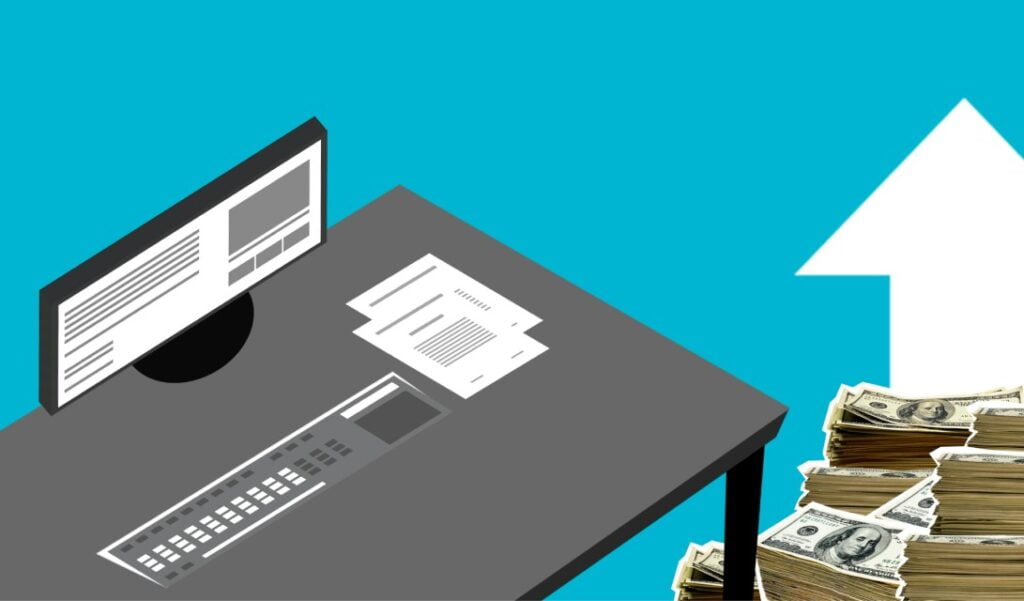If you don’t keep track of your cash flow as a business owner, you could go bankrupt. A study by the US Bank found that bad cash handling is the main reason why 82% of businesses fail.
Is it simple enough for your business to make more money than it spends? A good cash flow includes a lot more than just making money, even though it sounds easy in theory. Even if your business is making money right now, it could still go into negative cash flow. One common example of this is when you owe money on future bills but can’t make them because you didn’t get the money when you were supposed to.
By improving your company’s cash flow, you can help it make more money faster, meet its goals more quickly, and reduce its running costs. Need help getting more cash for your small business? These 17 tips will help your business’s cash flow.
Table of Contents
1. Figure out your cash flow first.
All businesses need to be able to accurately predict their cash flow so they know when they might not be able to pay their bills. For at least the next three months, but preferably longer, make a weekly or monthly cash flow estimate. Make a list of all the cash you expect to receive and when they are due to be paid. Add up all of your planned payments for expenses. Find the net amount of cash on hand. If the net cash amount is negative, it means that it might be harder for you to pay your bills.
It’s important to keep your books up to date when making a cash flow plan. Even though it can be hard to keep up with billing and handling costs, if you can, you’ll be able to make more accurate predictions that will help your business succeed in the future.
You might also want to set up a credit control system to keep track of your trade debts, or people who owe you money. In this way, you can get the money when you expect it to arrive, instead of having to chase down late payments that could turn into old bills.
2. Think about what could go wrong and know what the problems are in your field.
Your forecast will be affected not only by what you plan to do in business but also by things that happen in the world that are out of your control like staff costs going up because of pay raises tied to inflation. However, planning for different outcomes can help you see how they might affect your cash flow. What would take place if:
Costs of distribution go up?
The cost of raw materials goes up?
Do customers take longer to pay their bills?
Do taxes or interest rates change?
If you plan for different possible futures, you can see how your business might handle changes in the future. This gives you confidence that you could handle any short-term drops in sales or higher costs.
Different fields have different problems with cash flow. Here are some examples:
Businesses that make things and have stock and work-in-progress can have a lot of cash stuck in the business.
Tradespeople might have to buy things before getting paid.
Businesses that receive funds in foreign currencies may find it harder to make budgets when exchange rates change.
By knowing the problems that your industry faces, you can put your business in the best position to handle tough economic times.
3. Think about the value of your one-day cash flow.
Manager and Head of Working Capital Solution Development at Bank of Scotland, Merisa Lee Gimpel, says, “Think about how much one day of cash flow is worth to help you understand how important it is.” Marisa tells you to think about what would happen if you:
you might be able to get your money faster
You couldn’t sell your stock until the next day.
You could pay your sources the next day.

When you think about these possible outcomes, they can help you understand the trade-off between cash flow and profit. You can use what you’ve learned to help you ask for longer payment terms. Your cash flow will be much better if you take care of your trade creditors. This will give you more time to get paid by your customers. These tips will help you keep your money for longer:
Paying off debts before they’re due is against the terms of your deal.
Talk about getting longer payment terms.
If you don’t want to pay all at once at the end of a deal, offer monthly or yearly payments.
Put off argued debts with sellers, but make sure you pay your bills on time.
If you need short-term cash flow help, you could also talk to other creditors, like HMRC and loan companies, about how to pay them.
4. Give your team training in cash flow.
Your sales, buying, and stock management teams should all know how important it is to handle cash flow and work together with your finance team to do so.
This could mean that the sales team gives different customers different payment terms based on how much they buy or how they’ve paid in the past. Your purchasing staff may talk to sellers about giving you longer payment terms or letting you pay in installments. Someone from your stock management team might talk to someone from sales about running a deal to sell a product that isn’t moving fast enough.
5. Communicate well with people in your work
People on your team will be much better able to handle any cash flow problems if they know how to make accurate predictions. When you talk about cash flow, make sure that all the important offices are included, and make sure that everyone is involved in regular updates of the forecast.
Lastly, compare the estimate to the actuals with the right people on the team to figure out why there were any big differences. This will help you make better predictions in the future. There will be differences, but the goal is for your team to be more realistic about sales, purchases, and stock levels so that they can make better predictions for the future.
6. Make sure you get paid on time.
Marisa Lee Gimpel says that communication isn’t just important within the company; it can also help cut down on payment delays. This is very important when your business is small and you’re working with bigger companies. To get paid faster, you could do the following:
Before you hire someone, check their credit, and if you’re not sure, ask them to pay upfront.
Send out bills quickly and make sure they have all the right information on them so that payment goes smoothly.
Go after customers whose bills have been late for the longest time or who have a past of not paying on time.
Set clear steps for what to do when someone is late on a payment, and only be flexible in certain situations, like a death in the family.
If you are willing to accept part payment, you might want to talk about disputed bills that have been unpaid for a long time.
If you need to, give your credit control to a specialized company.
Ask people to pay early in return for a discount for paying early.
Talk to your customers about changing their payment terms so that you can give them less credit.
Even if it makes you feel bad, don’t be afraid to stick to the rules of your contract when prices are going up and everyone is feeling the pinch.
7. Keep an eye on things and manage
Managing your cash flow should be something you do every month as part of your normal financial routine. To do this right, you’ll need up-to-date information on your cash flow, trade debts, credits, goods, and fixed assets.
Most of the reports you need should be able to be made by your financial system, so you can:
Aged debtors: Which bills are past due and by how many days?
Credit terms: what terms do you give, and should certain users be able to change them?
What other benefits are there? Do early payment discounts help lower your trade debtor amount over time?
Aged creditors: what bills do you owe and how long are they past due?
Talk to your suppliers about payment terms. What terms are they giving you, and is it possible to get longer terms?
Stock levels: How much stock do you have, and how long does it take to sell something?
This is the amount of time that your business usually has money that isn’t being used. This is what it’s made of:
how long do most of your customers pay
the length of time that your stuff stays in storage and on shelves
your providers get paid most of the time
When the average amount of time that cash sits in your business grows, it’s time to think about what you can do to shorten the conversion cycle.
It might seem like a lot of extra work to do cash flow projections on top of your regular paperwork and financial reporting, but if you always have a clear picture of your cash position, your business is much more likely to be able to handle tough times.
8. Keep an eye on your fixed assets and stock.
Stock is the raw materials and produced things that you keep until they are sold. It might be possible to get more cash if you can cut down on the amount of stock you own. It also includes overhead costs, which are the costs your business has every month whether it sells anything or not. It’s especially important to look at these costs if your sales have gone down and aren’t expected to go up for a while.

To keep your stock prices down, think about the following:
Using a “just-in-time” method to buy production materials will help you save money on costs like inventory management and storage. This should be weighed against the need to be flexible and quick to adapt to changing customer needs, especially since supply lines are full of risk and doubt.
Talk to your owner about lowering your rent or giving you a rent-free time.
If you can, try to get better terms on your energy and other costs.
If you have too many employees, you might want to think about shortening the work week instead of firing them. This will make it easier to hire more people when the economy gets better.
Things that help your business make money are called fixed assets. Property, plants, tools, computers, equipment, and cars are all examples of assets. Many times, fixed assets take longer to sell than current assets like debts, and they can tie up a lot of cash.
Every once in a while, you should look over your fixed assets ledger to find simple ways to lower your fixed assets:
Think about the money you want to spend on capital—do you need it?
Can you lease instead of buying to save money each month?
Could you sell things that aren’t being used to make money?
9. Get help from an accountant
When leaders work with their accountants to compare where they are now (money coming in and going out) to where they want to be, that’s the most important thing they can do. Once you understand that, you’ll be better able to figure out what changes you need to make to your choices to reach your goal. When you’re ready to decide, you can go back to the model and see what will happen.
10. Know How Much Cash You Need
Cash flow is a key part of growth. The best way to manage cash flow is to know how much cash you need, minus any loan payments. Building cash measures and reviewing success all the time leads to benefits. You can get out of business. Businesses can plan their course, or change their course, by setting cash goals and keeping track of their success while knowing how much cash they need in total.
11. Manage your inventory proactively
Executives can improve working capital management by keeping an eye on goods, making better payment terms, and getting more money owed to them. A stable cash flow situation can also be reached through good contact with stakeholders, managing risks, and smart financial planning. They should also think about how technology might help automate tasks and cut costs.

12. Change how contingency plans are set up
To get the most out of your business’s running success, put clear plans into action that include specific metrics for each area. This should make the balance sheet stronger. Make backup plans for changeable costs so that they can be cut quickly if the bottom line goes down. Create action plans to raise costs only if desired top-line measures are met and expected results can be reached. – David Samuels, CEO of DrFirst, Inc.
13. Hold talks with your suppliers.
Don’t be afraid to talk to your suppliers about terms. Ask them if they can give you longer terms than their usual ones, like net 45 or net 60, or if they would accept payments every month or every three months instead of all at once. You might have to give up some price, but the deal might still be cheaper than other ways to get money on the market.
Related Post: 10 WAYS TO EARN GOOD INCOME BY STITCHING
14. Do these nine things.
To get a better handle on cash flow and working capital, leaders should:
1. Predict correctly how much cash will move.
2. Streamline the ways you bill and get paid.
3. Reward people who pay early.
4. Make the best use of your goods.
5. Talk to your sources.
6. Check your customers’ credit.
7. Get access to short-term loans.
8. Look over your spending and cut it down.
Put extra cash into short-term investments with low risk.
15. Overdrafts should be a backup plan.
These can be handled by being aware of your customers’ buying and paying habits ahead of time, using an automatic credit control system, and building strong relationships with your vendors. Since overdrafts are based on usage and can be used as a short-term fix for seasonal gaps in cash flow and working capital, having them as a backup plan may save money.
16. Take advantage of the “Cash Flow Trifecta.”
The “Cash Flow Trifecta” is a way for leaders to improve cash flow: 1. Streamline debts by sending out invoices quickly and following up on them; 2. Talk to vendors about better payment options and 3. Get rid of assets that aren’t doing well and put your money into things that will earn you more. This all-around method makes sure that managing working capital goes smoothly and quickly.
17. Make budgeting and planning better.
There are now more tools than ever to help you plan, and businesses should start using them to better figure out how much cash they will need. Finding any risks and making sure that the business or private insurance company has enough cash on hand to make sure that it can pay for things when it needs to is another important factor.

In Short
When things run easily and efficiently, there is a healthy flow of cash. Taking some or all of the 10 steps above should help you get more cash flow into your business. However, you’ll also need to make sure you’re making the right choices about your marketing, customer service, product or service growth, and getting new customers.
That’s why it’s important to keep your business plan up to date and review it often to make sure you can see trends and problems coming before they hurt your profits.
